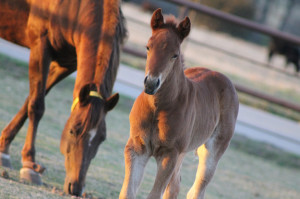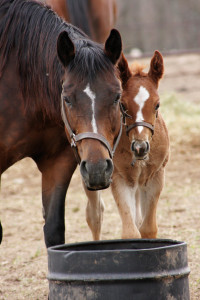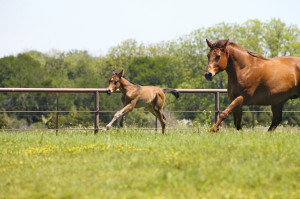Helping Your Foal Get a Head Start in Life
Click here to read the complete article
by: Megan Arszman
 The months of preparation, anticipation, and planning all come to a head one night when your mare’s water breaks and you witness the miracle of birth. Foaling season is now in full swing, and hundreds of foals—golden, spotted, splotched, and accented with chrome—are making their way into the world and into our hearts.
The months of preparation, anticipation, and planning all come to a head one night when your mare’s water breaks and you witness the miracle of birth. Foaling season is now in full swing, and hundreds of foals—golden, spotted, splotched, and accented with chrome—are making their way into the world and into our hearts.
“Every time I’m having a baby, I’m thinking I’m having the next great one,” says Joan Schroeder, breeder and owner of successful AQHA stallion Blazing Hot.
Whether it’s a large operation like Schroeder Ranch or an individual horse owner with only one mare in foal, anxious horse breeders are preparing for their new arrivals. Most people already have a game plan for the actual foaling process, but it’s equally important to have a game plan for working with your foal to help jumpstart development during those precious first months.
“It’s the coolest thing to be the first one they see, drying them off, and feeding them their first meal,” says Shelley Donovan of BSB Quarter Horses, in Sturgis, Michigan. “Then, watching them have successful show careers or just changing one person’s life is so rewarding.”
Those First Moments
The first hours of a foal’s life are filled with excitement and concern. This usually involves watching over the mare and foal to make sure the newborn is able to stand and nurse and that the mare is already recovering from the birthing process. Some breeders differ in their plan of action at this point. Some leave things up to Mother Nature and allow the new pair time to themselves. Others want to start the human-horse bond with immediate imprinting.
“I strongly believe in putting a little bit of time in with them as baby-babies,” explains Schroeder, who has been an AQHA breeder for more than 30 years. “When they’re first born, I leave the mare to them. Generally, if there are no problems with the mare or foal, then on Day 1, when they’re 24 hours old and nursing, I spend time with the foal. I scratch them and get my hands on them, so there’s that trust. That makes it simpler for me to handle them and worm them.”
The girls at BSB Quarter Horses (Kim Rotenberry, Hedy Levin, and Shelley Donovan) foal out 40-50 mares a year, and each foal immediately gets attention from farm staff. “We have learned over the years that the earlier we start, the easier it is on our bodies and the foals,” explains Donovan.
Anne Prince of Prince Farm, a 20+ year AQHA breeder of Halter and Performance horses has her own philosophy. “Our philosophy is consistency and understanding the foals. It’s really important for the foals to understand what we ask of them.”
Andrea Simons of Simons Show Horses believes in allowing foals to be foals and horses to be horses. “We feel like we need to let them develop themselves over their first year and not be too overexposed to people,” she explains. “We don’t do much with the foals unless they’re sick, so we’re not in their faces a whole lot. There are a third of the babies we have every year that come up to us, because they’re curious. We want our foals to be respectful; we don’t like the foals that try to run over top of you.”
Leading the Way
 When it comes to halter breaking foals, many wonder how soon is too soon? Some breeders will equip foals with figure-eight halters, that have short leather catch straps attached, within the first couple of weeks of life. Others simply let the foal follow his mother to and from the pasture for a short while.
When it comes to halter breaking foals, many wonder how soon is too soon? Some breeders will equip foals with figure-eight halters, that have short leather catch straps attached, within the first couple of weeks of life. Others simply let the foal follow his mother to and from the pasture for a short while.
Donovan: “We have figure-eight halters with catch straps to start. Any time we go in the stall, we gather the foals and touch and rub on them. We start ‘leading them’ right away. The first few times [sometimes longer with the slow learners] one of us will take the mare and the other will follow with the rope on the baby, but no pressure. Gradually, we’ll walk beside the foal and use a little pressure to lead. If they resist, we have butt ropes ready to encourage. Most get the hang of it pretty quick. The three of us lead every mare and baby outside and back inside every day.”
Prince: “When they’re newborns, during the first six to eight weeks, we don’t mess with a halter. We use a rope that wraps around their chest and butt to guide them along, because they want to follow mom. We take them to the paddock each day with their mothers. One person handles the mare and one person handles the foal. We start within the first 24 hours of them being handled.
“They’re typically three to four months old before we prepare them to lead. That’s when we eventually get the foal into a halter and butt rope, and the mom is an assistant as far as teaching them how to lead. They’re pretty willing to lead on their own. Before we turn them loose and get to the halter stage, we’ll work with them in the stall and mess around with them a little bit. They learn that if they take a step toward the pull, we’ll release the tension. It doesn’t take them long to figure out that when they come, the tension goes away. We try to make it part of the routine and no big deal.”
Schroeder: “To me, handling foals early is really important because then it’s a less stressful thing when you go to halter break them. If you’ve never laid hands on them, except to vaccinate and worm them, halter breaking can be difficult. It’s important to work with the foals early. Once you have that rapport with them, it’s easier to put the halter on them. First, I put a lead rope on the halter, and I take them back to the stalls. The next day, I’ll let them wear the halter and lead rope in the stalls for a day. I’ll let them fight with the halter and lead rope, instead of me fighting with them. Then, two of us will take the mare and baby to the pen.
“At that point, I just put a butt rope over them [an inch-thick cotton rope so it’s not anything that hurts them] and it comes up over their back and into the hands of the handler. The best way is to pull on the lead rope a little to one side or the other so you have a little pressure and [at the same time] put a little pressure on the butt rope. When they come to me, I pet them and give them release, because that’s what I want. It doesn’t take any time at all for them to figure out that if they come to me when they are led, there are no problems and they’re rewarded.”
Simons: “Upon weaning, we’ll have the foals spend time with donkeys, which usually only lasts a day, maybe two. They eat with the donkeys and drink with the donkeys. From there, they go on the hot walker to learn how to walk on the walker. Once that’s done, we turn them back out. We don’t really mess with them unless they’re going to go through a yearling sale or doing longe line.”
Baby’s First Vet Visit
For horses and humans alike, doctor appointments can be no fun. Those first couple of visits can be very stressful for foals, but early preparation can help to make it less scary for the foal and easier on your veterinarian and farrier.
Prince: “It all goes back to them not being afraid and being receptive. We’ll put the foal against the wall and ask them to be still while we take a leg away. We’ll mess with their muzzle, pretend we’re using a twitch, or just looking at their teeth. Typically, because we’re such a big farm, we’ll do everything in house. When they’re twelve hours old, we’ll draw blood and start taking their temperatures twice a day, so they’re used to having basic vet procedures performed on them from day 1.
“We wait until about six to eight weeks for farrier care, because it’s all about them learning to balance and accepting having that foot up. We don’t ask for much—we ask them to pick up one leg and hold it for a couple of seconds. When they hold still, we let go of the leg and they figure that out. We try to not make it a big deal and let it come naturally.”
Donovan: “We do all the worming and vaccinating of our babies ourselves. One of us has a big-toothed curry and rubs all the itchy spots while the other medicates. Most times they don’t even realize anything was done to them. After a few times of worming, I can usually get all foals wormed without any help, even when they are living outside. We usually remember each foal’s favorite itchy spot, and we find them years later when we visit!”
Schroeder: “This is why I find it important to spend time within the first week, so the foal can trust me. It’s like a child with vaccinations—none of them like it and they know it’s coming. However, if they trust in you and you’re able to love on them after they’ve had a vaccination, it’s going to make everything so much easier the next time around.”
“Blacksmithing is something that doesn’t happen before four months because our babies are all turned out. They’re in their stalls at night, but they’re out daily.”
 Stepping Out on Their Own: Weaning
Stepping Out on Their Own: Weaning
Weaning is probably the one aspect equally dreaded by breeders and their charges alike. The typical age range for weaning is four to five months, and most large-scale breeders will pasture-wean in groups of two to four. This offers foals support as they separate from their mothers.
Prince: “We’ve tried a lot of approaches in our 20+ years of breeding. About a decade or so ago, there was a fad going on with pasture weaning, where you put the mares in a pasture right next to the foals’ pasture. They couldn’t nurse, but they still felt their presence. Over time, scientists researched cortisol levels on the foals and found out this process was actually more stressful on the foal than ‘cold turkey weaning.’ So we typically cold turkey wean them, and we try to do the whole lot at the same time so the foals will comfort each other while they’re missing their moms. Also, we remove the mares from hearing distance from the foals. Truly, if they’re ready to be weaned, we start creep feeding the babies if they start showing interest, so they’re generally eating well and pretty independent and fine with each other anyway. It’s just amazing that within a day or two they quit screaming and they just look for each other and start playing. We find it’s not overly stressful, other than the first 12 hours, for the foal.
“Typically, because everyone has buddies already, they’re going back to the same paddock without mom. We try to keep the routines established in place to lower their stress levels, because the only thing different is that mom’s not there. At that point, they don’t miss the milk; they’re only missing the security of mom not being there, but it’s not a horrible process. We don’t dread it.”
Schroeder: “I never wean a baby before five months, unless the mother dies or something happens. Some might be at five months of age in July, and that’s the hottest time of the year in Texas. You don’t want to stress the babies out at all, if you can help it.
“Ideally, I wean four to six foals at a time. I’ll bring in the mares, and I put them into our stalls that are screened and see-through. The baby is running around, so this isn’t a time to halter break or do any heroics, just let them be and let them run around. I’ll bring a mare inside in the morning so I can watch them during the day. Then, the next day, I feed the foals, and everything is pretty much the same. After the third day, I take the mares away. At that point, the foals start getting turned out in small paddocks together. They come in at night and we’ll mess with them. Generally, they’re completely weaned and not upset within a four-day period. It’s pretty fast and easy.”
Donovan: “We do what we call a mass weaning. After the breeding and foaling season, we usually need a break, so the kids and their moms get to live outside in big groups to be horses for the summer. That way, if we need to go to a horse show, it’s not as much work at home. We check the almanac around September and will wean the oldest group. After the Congress, the rest are weaned. Since they have been handled all along, it usually isn’t too difficult, and our girls are ready to be rid of foals.”
Horse-Eating Brushes, Blankets, and Clippers
Introducing foreign items such as tickly brushes, horse-eating blankets, and small, but loud noisemakers that trim whiskers can create a stressful situation for foals. In nature, horses don’t worry about having their muzzle smooth or wearing a blanket to keep warm, so taking things slowly is very important when it comes to introducing these items to the foal.
Schroeder: “I don’t do clipping until after they’re weaned—there’s no point. Everything happens easily due to the groundwork that was put on them from the very beginning. If they’re trusting of you, just like when putting a halter on, it’s so much easier when you’ve had your hands on them all along. If you haven’t done that, then maybe they will balk and resist. If you have, they are much more trusting. During winter of their yearling year, if we’re going to put blankets on for sales or shows, we just do it carefully. If you’re holding them, they’ll trust you easily. It’s the same with clippers—ease up to them; don’t run up to them with the clippers blazing.”
Prince: “By the time we get to worrying about clipping, for the foals that have been foaled on our farm and have gone to school with us, this isn’t a big deal. We’ll place the clippers on their neck and run it down their shoulders with the clippers turned on so they can get used to the vibration. We’re very cautious and use sharp, cool blades. Don’t let them get overheated. Typically, if you introduce the clippers slowly and easily, it’s not a big deal. It’s just another step to the next level.”
Trust Takes Patience
When it comes to raising foals there may not be any true right or wrong way to do things. It’s about doing what’s best by the foal to ensure he or she has a successful career later on in life.
“Never lie to them,” Prince says. “As soon as you’ve misled them into a dangerous situation or a situation where they become frightened, it’s a lifelong lesson that they will learn and it will rear its ugly head at times when you don’t want it to. Whatever it is, I just try to be really slow with them and let them tell us when it’s time for the next step. If you try to press your foal or get in a hurry with any part of the process, it’s going to come back and take you a whole lot longer. We try to remind each other that patience is truly a virtue when working with babies.”
Ultimately, remember that when raising babies, the unexpected can always happen. “There’s a lot of work, a lot of common sense, and a lot of love that goes into foaling and raising babies,” Schroeder says. “That’s why some people are more successful at it. It has to be a passion, in my opinion. You must love the horses themselves and they will most definitely prosper, as will your own business,” she concludes.










